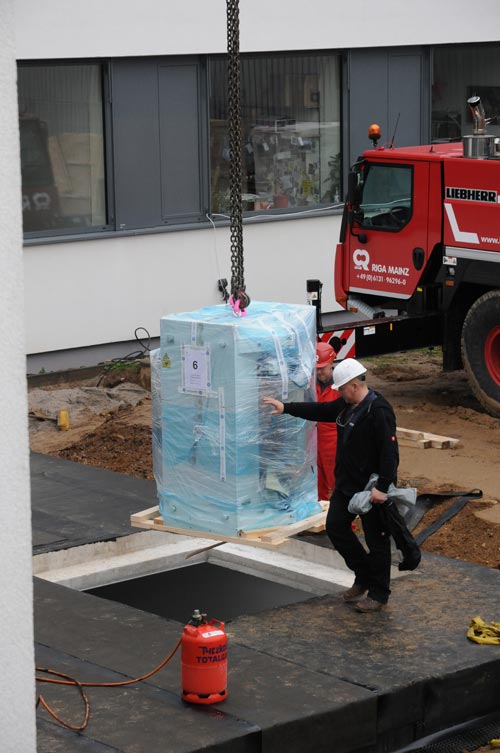Mainz University installs a new particle accelerator

Installation of the cyclotron on the campus of Johannes Gutenberg University Mainz photo/©: Heinz-Martin Schmidt
A new particle accelerator will further enhance the research landscape at Johannes Gutenberg University Mainz (JGU). It is to be employed to conduct research into potential applications of medical relevance. The new cyclotron has been installed in a basement structure of the Institute of Nuclear Chemistry on the Gutenberg Campus.
It will be used to generate short half-life isotopes, which will be principally used for fundamental research but are also required for the medical imaging technique known as positron emission tomography (PET). The cost of this large-scale research device amounts to about EUR 1 million provided by the German Research Foundation (DFG) and the Rhineland-Palatinate Research Initiative. Commissioning of the new cyclotron is planned for spring 2016.
The cyclotron is a ring-shaped particle accelerator that occupies a floor space of some 7.5 square meters and has a height of two meters. It weighs about 50 tons and a crane had to be used to lower it through a hole in the ceiling into the designated basement room. In addition to the cyclotron room, the new structure has a technical and control center together with an access lock. The structure is linked directly to the Institute of Nuclear Chemistry extension building and has all safety-relevant features.
As it will be able to accelerate protons to an energy of 9.7 mega-electron volts (MeV), the cyclotron at Mainz University can be used to generate the two radioactive elements fluorine-18 and carbon-11. These will be mainly employed for chemical and pharmaceutical research purposes but are also necessary for the PET medical diagnostic imaging technique.
F-18 and C-11 have short half-lives of just 110 and 20 minutes respectively. It is thus necessary to generate them near the location at which they are to be used to ensure that they are available in sufficient quantities. It has not previously been possible in Mainz to create radiopharmaceuticals labeled with C-11 because of its particularly short half-life. The new accelerator has now made this feasible.
“The cyclotron will enhance our currently existing infrastructure and eliminate a bottleneck in the production of radioactive nuclides,” explained Professor Frank Rösch of the JGU Institute of Nuclear Chemistry. “It will significantly facilitate the development of new radiopharmaceuticals and their preclinical evaluation while – working in collaboration with the Department of Nuclear Medicine at the Mainz University Medical Center – we will be able to markedly expedite their future application in patient diagnosis.”
There are additional benefits to be expected through interdisciplinary joint projects in which the areas of nuclear chemistry, pharmaceutical sciences, organic chemistry, and nuclear medicine at JGU will collaborate with regard to the development and evaluation of new PET radiopharmaceuticals, in some cases also with external institutions such as the Department of Psychiatry, Psychotherapy, and Psychosomatics at RWTH Aachen and the Mainz-based Max Planck Institute for Polymer Research.
Photos:
http://www.uni-mainz.de/bilder_presse/09_kernchemie_zyklotron_einbau_01.jpg
Installation of the cyclotron on the campus of Johannes Gutenberg University Mainz
photo/©: Heinz-Martin Schmidt
http://www.uni-mainz.de/bilder_presse/09_kernchemie_zyklotron_einbau_02.jpg
Installment of a cyclotron door into the newly constructed cyclotron building
photo/©: Heinz-Martin Schmidt
http://www.uni-mainz.de/bilder_presse/09_kernchemie_zyklotron_einbau_03.jpg
(fltr) Professor Tobias Reich (Managing Director of the Institute of Nuclear Chemistry), Professor Norbert Trautmann (Institute of Nuclear Chemistry), Dr. Waltraud Kreutz-Gers (Chancellor of Johannes Gutenberg University Mainz), Professor Georg Krausch (President of Johannes Gutenberg University Mainz), and Professor Frank Rösch (Institute of Nuclear Chemistry) observing the installation of the new cyclotron
photo/©: Heinz-Martin-Schmidt
Further information
Professor Dr. Frank Rösch
Institute of Nuclear Chemistry
Johannes Gutenberg University Mainz (JGU)
55099 Mainz, GERMANY
phone +49 6131 39-25302
fax +49 6131 39-24692
e-mail: frank.roesch@uni-mainz.de
http://www.kernchemie.uni-mainz.de/radiopharmazie-roesch/117_ENG_HTML.php
Related links:
http://www.kernchemie.uni-mainz.de – Institute of Nuclear Chemistry
http://www.uni-mainz.de/presse/19663_ENG_HTML.php – press release “German Research Foundation, Rhineland-Palatinate, and Mainz University invest more than
EUR 2 million in a cyclotron and its building complex” (19 October 2015)
http://www.uni-mainz.de/presse/20010_ENG_HTML.php – press release ;
http://www.kernchemie.uni-mainz.de/eng/index.php – Institute of Nuclear Chemistry ;
http://www.uni-mainz.de/presse/19663_ENG_HTML.php – press release “German Research Foundation, Rhineland-Palatinate, and Mainz University invest more than EUR 2 million in a cyclotron and its building complex” (19 Oct. 2015)
Media Contact
All latest news from the category: Life Sciences and Chemistry
Articles and reports from the Life Sciences and chemistry area deal with applied and basic research into modern biology, chemistry and human medicine.
Valuable information can be found on a range of life sciences fields including bacteriology, biochemistry, bionics, bioinformatics, biophysics, biotechnology, genetics, geobotany, human biology, marine biology, microbiology, molecular biology, cellular biology, zoology, bioinorganic chemistry, microchemistry and environmental chemistry.
Newest articles

Making diamonds at ambient pressure
Scientists develop novel liquid metal alloy system to synthesize diamond under moderate conditions. Did you know that 99% of synthetic diamonds are currently produced using high-pressure and high-temperature (HPHT) methods?[2]…

Eruption of mega-magnetic star lights up nearby galaxy
Thanks to ESA satellites, an international team including UNIGE researchers has detected a giant eruption coming from a magnetar, an extremely magnetic neutron star. While ESA’s satellite INTEGRAL was observing…

Solving the riddle of the sphingolipids in coronary artery disease
Weill Cornell Medicine investigators have uncovered a way to unleash in blood vessels the protective effects of a type of fat-related molecule known as a sphingolipid, suggesting a promising new…





















